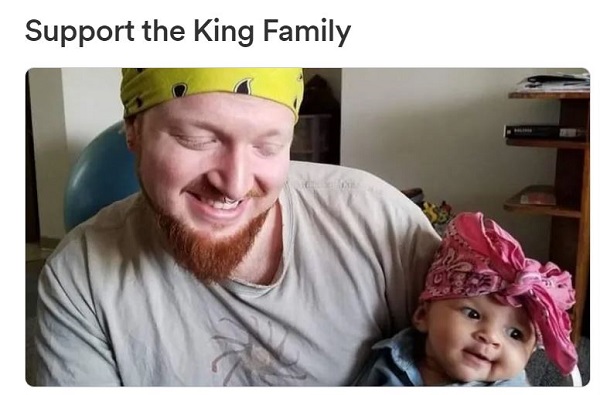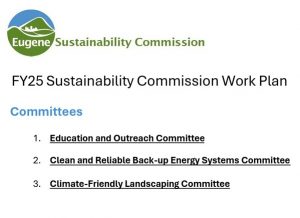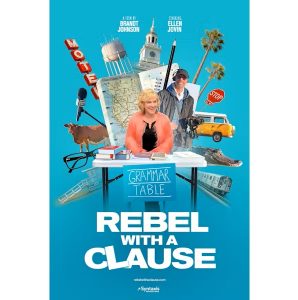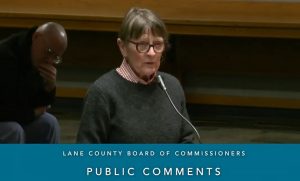David Zupan: ‘Legacy of shame’ in UO actions on low-income housing
10 min read
DJ Suss D: In the wake of the Candice King family rent strike, they have a GoFundMe site because they were evicted finally from the rent strike property. And so now they’re looking to do a land trust at another location. So you can go to their EugeneRentStrike.org website and find out about their GoFundMe site if you want to support that.
[00:00:22] And I hope you do, because I did a callout for a history of rent strikes in Eugene, of rent abuse in Eugene. And David Zupan emailed me of Eugene Peace Works about Amazon housing, Amazon Student Housing for the U of O, that they destroyed perfectly fine, cheap housing. And there’s a history of this in Eugene, of destroying perfectly good, cheap housing so that developers and the university and other players, big players, can make more money and more profit, when it was perfectly fine and could just be restored and would be sustainable the way it was.
[00:01:05] David Zupan: Amazon refers to the Amazon Student Family Housing under the University of Oregon. And it was there for many years using, World War II shipbuilders buildings that were shipped down from Vanport.
[00:01:27] I think they got it for a ridiculously low, low amount of money. And it was put up on the site where Spencer View Apartments are now. And there were 48 buildings. And most importantly, it was initially for GIs and their families so they could come back to get their education after the war.
[00:01:54] There were a lot of people who knew a lot about self-administration and so people became very interested in making sure that the place continued as a low-income housing resource.
[00:02:10] But the university had other plans. They kept talking about it as being temporary housing that they were going to tear down and replace. And that was a long-time debate / struggle between the residents there who wanted to keep it indefinitely because they saw how valuable a resource it was, and the administration of the university. So one of the things they would do is not maintain the place very well. And so the rent strike evolved when they threatened to increase the rent.
[00:02:49] That was a relatively small amount, but every dollar counted back then, as well as it does now. And folks were organized enough to call for a rent strike, which involved people, instead of paying their rent, put the money into an escrow fund that was created. And we used that as a bargaining chip, and it went on for several months.
[00:03:13] It got to the point where we had about $20,000 in it. And the university did negotiate that. We didn’t stop the rent increase, which was $250, but we did get a daycare center. They agreed to build a daycare center on the site and a playground. And also gave us more autonomy in helping to run the place, giving us more of a voice in how it was run.
[00:03:43] So we saw it as a real victory. On the eve of our turning the money over to the university at Oregon Hall, one of our artist activists said, ‘Well, since it’s such a large amount of money, why don’t I make a large check.’ So she created a replica of a check that was five feet long and three feet tall.
[00:04:05] So we took that in to Oregon Hall, went up to the counter and presented it. And the clerk there said, ‘Well, we can’t accept that.’ And we said, ‘Oh, okay.’ And so we all started, there were several of us, we all started walking out the door. Just before we got to the door, somebody yelled out, ‘No, no, come back! We’ll accept it. It’s fine.’
[00:04:29] We got a good laugh out of that and it was a real lesson for me personally because it was my first real action where I saw how people, when they take action collectively, can really make a difference. If you try to do it by yourself, more difficult if not impossible sometimes.
[00:04:50] So the power of collective action for social change was dramatically taught to me and that began, actually, it helped influence my staying involved in activism for the rest of my life.
[00:05:07] DJ Suss D: I met you in the ‘90s over Amazon housing when these buildings that you’re talking about must have been structurally sound, right? Because they can’t move a building that is not structurally sound. They basically moved most of these buildings and got rid of them and then raised the rents. And they make more profit because these rents are higher. And because profits are a percentage of rent, the university makes more money by charging higher rents with supposedly better-quality buildings.
[00:05:35] David Zupan: I joined with students and others from the community to basically do what we had done before, which was resist what the university was planning. They basically wanted to tear the whole place down, all 48 buildings, and replace it with some, what turned out to be ticky-tacky apartments.
[00:05:58] And yeah, it was going to be much higher rent and that was our main issue: This is too valuable a housing resource. It was low-income housing that was affordable for students including international students and single moms and so forth that live there. So it was a real community, and as it had happened in the city in the 1970s, we had proposed a housing co-op.
[00:06:27] The university would retain ownership, but we would basically manage it, run the whole place for them. And we would also renovate all the buildings. It was in need of renovation because the university hadn’t maintained it that well. We went out and found the funding in the community, several million dollars, actually, and said, ‘Okay, let’s do this.’
[00:06:50] The university initially said yes, as they had done back in the ‘70s. And so we put in thousands of volunteer hours to get ready for this to happen. And on the eve of that transition, the co-op would begin, they backtracked. They reneged on the agreement. And it was the same person who was involved in both the ‘70s and in the ‘90s.
[00:07:17] His name was Frohnmayer. He was an attorney. I think in many ways it was not just… It’s an economic thing to make more money. It was a political decision because Amazon was a real bastion, you might say, of liberal, if not radical, community organizers, obviously very well educated, and this was a way of eliminating that kind of activism.
[00:07:45] Some people dropped out right away because they were so surprised, shocked, that the university had done this. But many of us who have been involved in the ‘70s recognize the same pattern. You make a promise, then you renege on it at the last minute, hoping that your opposition will be so discouraged they’ll give up.
[00:08:03] We were ready for this. That began a two-year campaign of resistance. Amazon qualified as a National Historic Landmark District. It was one of the last housing resources of its kind that was set up for GIs to be able to get their education. And so it was one of the last of these GI family student communities still remaining with, and so large, you know, with 48 buildings, 250 units, all, as you said, very well made.
[00:08:36] They had been made with old growth timber up in Portland at Vanport. And then they had been, trucked down here. They had to be very well made, as it turns out. We got the National Historic Landmark status, which isn’t that easy. We had to do a lot of paperwork and meet all the requirements.
[00:08:59] That was one of the tools we had to try to protect Amazon from being demolished. The state, or the university in this case, has a lot of clout, and they, they were determined, Frohnmayer was determined to move ahead with us. So he kept pushing ahead, and he kept resisting, even after National Historic Landmark, he basically got the city of Eugene, which initially had supported the Historic Landmark effort, got them to cooperate with him as well as the state.
[00:09:34] Because it was a public resource, a housing historic resource, the university was required by law to put it up for sale instead of demolishing it. If that was their plan, and which it was because we had raised the money necessary to renovate the place, we offered to buy it outright. So they had to take our offer and their counteroffer, what they did was they built in a loophole and the loophole was they would sell the property, but there was 18 acres there and we had to pay the amount, but we also had to come up with the same amount of land that Amazon sat on.
[00:10:16] And it had to be within two miles of 13th and Alder. Well, as we all know, there isn’t that amount of vacant land within that two miles. So, basically what it was, was a loophole. And because the university had the influence of, by that time they were using the Justice Department, the state, power of the state, as well.
[00:10:45] And so they had state attorneys working on this. We took it all the way to LUBA, the Land Use Appeals Board. And they basically ruled that that loophole was okay, because they said, ‘Oh, well, they were required to put it up for sale. And they did that.’ Even though there was no way we could meet that requirement of the land exchange, they ruled that that was valid. No matter who they sold it to, they would have had to still done the mitigation. And it wasn’t that the mitigation was not affordable, it was that the mitigation was not available. There was also a PR battle going on, right? They were making the argument that these are old, old, broken-down buildings.
[00:11:35] They aren’t suitable, they should be replaced. And that was their PR spin. And we, of course, were countering that these buildings are completely subject to renovation and we’ll do the renovation. We did have a lot of support in the community as well as on campus, but basically the university proceeded ahead and I think we did appeal it and while it was under appeal, they started demolishing the place.
[00:12:10] We had what was called the Amazon Nine, who, they were folks who went down to the site and blocked the bulldozers for the day. One of them was former City Councilor Kevin Hornbuckle. They had their day in court, but, and it was a very courageous action on their part. And I think if we perhaps had more of that, and maybe more of it sooner, what could have worked.
[00:12:34] But they did demolish all the buildings. Because the other part of their spin was, ‘We won’t tear all the buildings down. We’ll set aside eight of the buildings and they’ll give some to St. Vincent’s and then some to a developer.’ That was kind of what they used in their PR fight against us. And it worked!
[00:12:55] And they did manage to tear down all 40 of the buildings. It was a huge resource and a waste of low-income housing. And that’s one of the reasons we have shortages today is because people didn’t have the foresight to keep Amazon. As it turned out, we have proof of that even today, that these places were completely restorable.
[00:13:24] Those eight buildings were moved, and you can see them today at the corner of 19th and Amazon. You can see the St. Vincent’s units there, they’re perfectly solid buildings that are working very well as low-income housing for St. Vincent’s. And then down the street a ways at Ferry and 19th Avenue, there’s an apartment complex made up of a couple of the Amazon buildings.
[00:13:53] So, it showed that they had to do that at, you know, some expense to move them and then renovate them. But if they’d been renovated on site, the cost would have been much less. And of course we had found the money to do it. The community had found the money to do it. So it was pretty outrageous that the University of Oregon under Frohnmayer did this. It’s a legacy of shame.
[00:14:23] As we’ve seen borne out from the 70s on up, basically the university is being privatized. It’s the corporatization of universities across the country. But particularly at the U of O, it’s not surprising, but I think the real story is the vibrant resistance that Eugene and the Amazon community united around.
[00:14:51] And it was revived again when the university did the same thing with Westmoreland in the 90s, when they privatized that whole student complex. I was involved in that campaign as well, which again had probably even more from community. And that too went all the way to the State Board of Higher Education where folks from the community went and said, ‘Hey, don’t, don’t privatize this. We need this lower-income housing because we’re students. We’re poor.’
There was single moms, again, international students. It was the same story all over again. I think it was having a real impact on the board. We’ve done a lot of lobbying around it. Then Frohnmayer got up in front of the state board and said, ‘We’ll take care of these students. Don’t worry. We’ll make sure they keep the rents lower.’ Arguing that. He was putting his reputation on the line. He spoke himself, before the state board, using all he could of his role as president to make sure that this process went through of privatizing Westmoreland. Which again, was another outrageous privatization of a public resource that was basically stolen from the community and contributed to, I think, the shortage of low-income affordable housing in this community. It’s important to have a lot of participation and a lot of community support, obviously.




